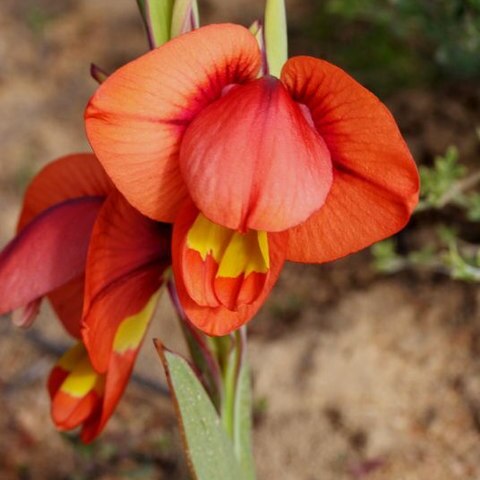Plants 150-300 mm high. Corm globose, 20-40 mm diam.; tunics firm-membranous to leathery, decaying irregularly, occasionally ± coarsely fibrous, often accumulating in a dense mass. Stem erect, compressed and ridged, usually 3-winged, with two wide and one narrow face, unbranched. Leaves 4(5), lower 2 or 3 ± basal and forming a 2-ranked fan, lowermost largest, reaching to just below base of spike, falcate, remaining leaves progressively shorter, 20-40 mm wide, obtuse-apiculate, margins heavily thickened, hyaline or reddish. Spike flexed at base and inclined, flexuose, nearly 2-ranked, 3-to 7-flowered; bracts prominently keeled with keels decurrent on stem angles, green with reddish keels and margins, outer 25-40(-50) mm long, 1-keeled, inner shorter, 2-keeled, minutely forked apically. Flowers orange to scarlet, lower lateral tepals yellow in lower 2/3, lower median tepal yellow in lower half, throat with glistening papillose ridges on sutures between tepals, lightly scented; perianth tube obliquely funnel-shaped, 10-15 mm long, entirely included in bracts; tepals dorsal largest, obovate-concave, hooded over stamens, 27-38 x 18-20 mm, upper laterals broadly heart-shaped, narrowed near base, curving gradually outward distally and spreading, 23-26 x 23-30 mm, lower 3 tepals united below for 3-5 mm, free parts ± 25 x 9-10 mm, clawed below, laterals channelled for most of length, lower median ± 18 x 12-15 mm. Filaments strongly arched, 17-25 mm long, exserted 13-20 mm from tube; anthers 8-14 mm long, cream-coloured with red on lines of dehiscence; pollen cream-coloured. Style arching over stamens, dividing opposite middle to upper 1/3 of anthers, branches 5-7 mm long. Capsules oblong-ellipsoid, 25-30 mm long. Seeds broadly ovate, 8-9 x ± 7 mm, broadly and evenly winged.
More
Cormous geophyte, 120-300 mm tall, corm with papery tunics, stem compressed and angled. Leaves broad, falcate, margins heavily thickened. Flowers few in a nodding spike, bilabiate, orange marked yellow to greenish, sweetly scented, upper tepal hooded.

